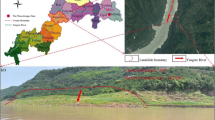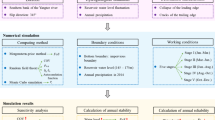Abstract
Landslide is a common geological hazard in reservoir areas and may cause great damage to local residents’ life and property. It is widely accepted that rainfall and periodic variation of water level are the two main factors triggering reservoir landslides. In this study, the Bazimen landslide located in the Three Gorges Reservoir (TGR) was back-analyzed as a case study. Based on the statistical features of the last 3-year monitored data and field instrumentations, the landslide susceptibility in an annual cycle and four representative periods was investigated via the deterministic and probabilistic analysis, respectively. The results indicate that the fluctuation of the reservoir water level plays a pivotal role in inducing slope failures, for the minimum stability coefficient occurs at the rapid decline period of water level. The probabilistic analysis results reveal that the initial sliding surface is the most important area influencing the occurrence of landslide, compared with other parts in the landslide. The seepage calculations from probabilistic analysis imply that rainfall is a relatively inferior factor affecting slope stability. This study aims to provide preliminary guidance on risk management and early warning in the TGR area.
Similar content being viewed by others
References
Wang F W, Zhang Y M, Huo Z T, Peng X M, Wang S M, Yamasaki S. Mechanism for the rapid motion of the Qianjiangping landslide during reactivation by the first impoundment of the Three Gorges Dam reservoir, China. Landslides, 2008, 5(4): 379–386
Huang F M, Huang J S, Jiang S H, Zhou C B. Landslide displacement prediction based on multivariate chaotic model and extreme learning machine. Engineering Geology, 2017, 218: 173–186
Corominas J, Moya J. Reconstructing recent landslide activity in relation to rainfall in the Llobregat River basin, Eastern Pyrenees, Spain. Geomorphology, 1999, 30(1–2): 79–93
Coe J A, Ellis W L, Godt J W, Savage W Z, Savage J E, Michael J A, Kibler J D, Powers P S, Lidke D J, Debray S. Seasonal movement of the Slumgullion landslide determined from Global Positioning System surveys and field instrumentation, July 1998-March 2002. Engineering Geology, 2003, 68(1–2): 67–101
Guzzetti F, Peruccacci S, Rossi M, Stark C P. Rainfall thresholds for the initiation of landslides in central and southern Europe. Meteorology and Atmospheric Physics, 2007, 98(3–4): 239–267
Liu J G, Mason P J, Clerici N, Chen S, Davis A, Miao F, Deng H, Liang L. Landslide hazard assessment in the Three Gorges area of the Yangtze river using ASTER imagery: Zigui-Badong. Geomorphology, 2004, 61(1–2): 171–187
Yang B B, Yin K L, Xiao T, Chen L X, Du J. Annual variation of landslide stability under the effect of water level fluctuation and rainfall in the Three Gorges Reservoir, China. Environmental Earth Sciences, 2017, 76(16): 564–580
Wang F W, Zhang Y M, Huo Z T, Matsumoto T, Huang B L. The July 14, 2003 Qianjiangping landslide, Three Gorges Reservoir, China. Landslides, 2004, 1(2): 157–162
Li D Y, Yin K L, Leo C J. Analysis of Baishuihe landslide influenced by the effects of reservoir water and rainfall. Environmental Earth Sciences, 2010, 60(4): 677–687
Zhao N H, Hu B, Yi Q L, Yao W M, Ma C. The coupling effect of rainfall and reservoir water level decline on the Baijiabao landslide in the Three Gorges Reservoir area, China. Geofluids, 2017, 2017: 1–12
Du J, Yin K L, Lacasse S. Displacement prediction in colluvial landslides, Three Gorges Reservoir, China. Landslides, 2013, 10(2): 203–218
Huang Q X, Wang J L, Xue X. Interpreting the influence of rainfall and reservoir infilling on a landslide. Landslides, 2016, 13(5): 1139–1149
Chen F Y, Wang L, Zhang W G. Reliability assessment on stability of tunnelling perpendicularly beneath an existing tunnel considering spatial variabilities of rock mass properties. Tunnelling and Underground Space Technology, 2019, 88: 276–289
Crosta G B, Agliardi F. Failure forecast for large rock slides by surface displacement measurements. Canadian Geotechnical Journal, 2003, 40(1): 176–191
Zhang Z H, Qian M M, Wei S, Chen J X. Failure mechanism of the Qianjiangping Slope in Three Gorges Reservoir Area, China. Geofluids, 2018, 2018: 3503697
Zhou C, Yin K L, Cao Y, Ahmed B. Application of time series analysis and PSO-SVM model in predicting the Bazimen landslide in the Three Gorges Reservoir, China. Engineering Geology, 2016, 204: 108–120
Yang B B, Yin K L, Lacasse S, Liu Z Q. Time series analysis and long short-term memory neural network to predict landslide displacement. Landslides, 2019, 16(4): 677–694
Guo H W, Zhuang X Y, Rabczuk T. A deep collocation method for the bending analysis of Kirchhoff plate. Computers, Materials & Continua, 2019, 59(2): 433–456
Anitescu C, Atroshchenko E, Alajlan N, Rabczuk T. Artificial neural network methods for the solution of second order boundary value problems. Computers, Materials & Continua, 2019, 59(1): 345–359
Rahardjo H, Ong T H, Rezaur R B, Leong E C. Factors controlling instability of homogeneous soil slopes under rainfall. Journal of Geotechnical and Geoenvironmental Engineering, 2007, 133(12): 1532–1543
Berilgen M. Investigation of stability of slopes under drawdown conditions. Computers and Geotechnics, 2007, 34(2): 81–91
Huang F M, Luo X Y, Liu W P. Stability analysis of hydrodynamic pressure landslides with different permeability coefficients affected by reservoir water level fluctuations and rainstorms. Water (Basel), 2017, 9(7): 1–16.
van Genuchten M T. A closed-form equation for predicting the hydraulic conductivity of unsaturated soils 1. Soil Science Society of America Journal, 1980, 44(5): 892–898
Fredlund D G, Rahardjo H. Soil Mechanics for Unsaturated Soils. New York: John Wiley & Sons, 1993
Miao F S, Wu Y P, Xie Y H, Yu F, Peng L J. Research on progressive failure process of Baishuihe landslide based on Monte Carlo model. Stochastic Environmental Research and Risk Assessment, 2017, 31(7): 1683–1696
Zhu H, Zhang L M, Zhang L Y, Zhou C B. Two-dimensional probabilistic infiltration analysis with a spatially varying permeability function. Computers and Geotechnics, 2013, 48: 249–259
Yang H Q, Zhang L L, Li D Q. Efficient method for probabilistic estimation of spatially varied hydraulic properties in a soil slope based on field responses: A Bayesian approach. Computers and Geotechnics, 2018, 102: 262–272
Vogel T, Van Genuchten M T, Cislerova M. Effect of the shape of the soil hydraulic functions near saturation on variably-saturated flow predictions. Advances in Water Resources, 2000, 24(2): 133–144
Rahardjo H, Li X W, Toll D G, Leong E C. The effect of antecedent rainfall on slope stability. Geotechnical and Geological Engineering, 2001, 19(3–4): 371–399
Rahardjo H, Leong E C, Rezaur R B. Effect of antecedent rainfall on pore-water pressure distribution characteristics in residual soil slopes under tropical rainfall. Hydrological Processes: An International Journal, 2008, 22(4): 506–523
Rahimi A, Rahardjo H, Leong E C. Effect of antecedent rainfall patterns on rainfall-induced slope failure. Journal of Geotechnical and Geoenvironmental Engineering, 2011, 137(5): 483–491
Zhang W G, Goh A T C. Multivariate adaptive regression splines for analysis of geotechnical engineering systems. Computers and Geotechnics, 2013, 48: 82–95
Wang L, Wu C Z, Gu X, Liu H L, Mei G X, Zhang W G. Probabilistic stability analysis of earth dam slope under transient seepage using multivariate adaptive regression splines. Bulletin of Engineering Geology and the Environment, 2020, 79(6): 2763–2775.
Hamrouni F, Trabelsi H, Jamei M, Olivella S. Numerical analysis of landslides caused by rainfall in a reduced physical slope model. European Journal of Environmental and Civil Engineering, 2019 (in press)
Zhou S W, Rabczuk T, Zhuang X Y. Phase field modeling of quasistatic and dynamic crack propagation: COMSOL implementation and case studies. Advances in Engineering Software, 2018, 122: 31–49
Zhou S W, Zhuang X Y, Rabczuk T. A phase-field modeling approach of fracture propagation in poroelastic media. Engineering Geology, 2018, 240: 189–203.
Zhou S W, Zhuang X Y, Rabczuk T. Phase field modeling of brittle compressive-shear fractures in rock-like materials: A new driving force and a hybrid formulation. Computer Methods in Applied Mechanics and Engineering, 2019, 355: 729–752
Zhou S W, Zhuang X Y, Rabczuk T. Phase-field modeling of fluid-driven dynamic cracking in porous media. Computer Methods in Applied Mechanics and Engineering, 2019, 350: 169–198
Acknowledgements
This work was supported by the Natural Science Foundation of Chongqing, China (Nos. cstc2018jcyjAX0632 and cstc2019jcyj-bshX0043), the High-end Foreign Expert Introduction program (No. G20190022002), and Chongqing Engineering Research Center of Disaster Prevention & Control for Banks and Structures in Three Gorges Reservoir Area (Nos. SXAPGC18ZD01 and SXAPGC18YB03). The financial support is gratefully acknowledged. The monitored data and historical records used in this study is from the Chinese National Field Scientific Observation Station of Landslide in The Yangtze Three Gorges.
Author information
Authors and Affiliations
Corresponding author
Rights and permissions
About this article
Cite this article
Zhang, W., Tang, L., Li, H. et al. Probabilistic stability analysis of Bazimen landslide with monitored rainfall data and water level fluctuations in Three Gorges Reservoir, China. Front. Struct. Civ. Eng. 14, 1247–1261 (2020). https://doi.org/10.1007/s11709-020-0655-y
Received:
Accepted:
Published:
Issue Date:
DOI: https://doi.org/10.1007/s11709-020-0655-y




